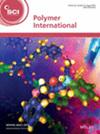求助PDF
{"title":"Biofunctional polyethylene terephthalate surface by CO2 plasma activation","authors":"Rohini Verma, Chetna Verma, Bhuvanesh Gupta, Samrat Mukhopadhyay","doi":"10.1002/pi.6756","DOIUrl":null,"url":null,"abstract":"<p>Polyethylene terephthalate (PET) fabric was functionalized by carbon dioxide (CO<sub>2</sub>) plasma treatment to introduce carboxyl (–COOH) functionality on its surface. The presence of hydrophilic groups increased the hydrophilicity and decreased the water drop absorption time as the plasma exposure time increased from 30 to 120 s. The maximum carboxyl content of 1.9 μg cm<sup>−2</sup> was achieved within 60 s exposure time, with 80 W discharge power and 40 cm<sup>3</sup> min<sup>−1</sup> gas flow rate. The surface chemistry of untreated and plasma-treated PET fabrics was analyzed using attenuated total reflectance - Fourier transform infrared spectroscopy (ATR-FTIR) and X-ray photoelectron spectroscopy (XPS). The surface morphology was monitored as a function of exposure time using field emission scanning electron microscopy (FE-SEM) and atomic force spectroscopy (AFM). The colony count method was used to study the <i>Escherichia coli</i> <i>(E. coli)</i> and <i>Staphylococcus aureus</i> <i>(S. aureus)</i> bacterial adhesion on the surface. Polyethylene glycol (PEG) (molecular weight 1000) was used to immobilize the plasma-treated surface. The results showed a significant reduction in the bacterial adhesion to the functionalized PET fabric compared to untreated fabric. However, the immobilization of PEG on the PET surface inhibited bacterial adherence significantly and imparted antifouling behavior on the fabric surface. © 2025 Society of Chemical Industry.</p>","PeriodicalId":20404,"journal":{"name":"Polymer International","volume":"74 8","pages":"657-666"},"PeriodicalIF":3.6000,"publicationDate":"2025-04-10","publicationTypes":"Journal Article","fieldsOfStudy":null,"isOpenAccess":false,"openAccessPdf":"","citationCount":"0","resultStr":null,"platform":"Semanticscholar","paperid":null,"PeriodicalName":"Polymer International","FirstCategoryId":"92","ListUrlMain":"https://scijournals.onlinelibrary.wiley.com/doi/10.1002/pi.6756","RegionNum":4,"RegionCategory":"化学","ArticlePicture":[],"TitleCN":null,"AbstractTextCN":null,"PMCID":null,"EPubDate":"","PubModel":"","JCR":"Q2","JCRName":"POLYMER SCIENCE","Score":null,"Total":0}
引用次数: 0
引用
批量引用
Abstract
Polyethylene terephthalate (PET) fabric was functionalized by carbon dioxide (CO2 ) plasma treatment to introduce carboxyl (–COOH) functionality on its surface. The presence of hydrophilic groups increased the hydrophilicity and decreased the water drop absorption time as the plasma exposure time increased from 30 to 120 s. The maximum carboxyl content of 1.9 μg cm−2 was achieved within 60 s exposure time, with 80 W discharge power and 40 cm3 min−1 gas flow rate. The surface chemistry of untreated and plasma-treated PET fabrics was analyzed using attenuated total reflectance - Fourier transform infrared spectroscopy (ATR-FTIR) and X-ray photoelectron spectroscopy (XPS). The surface morphology was monitored as a function of exposure time using field emission scanning electron microscopy (FE-SEM) and atomic force spectroscopy (AFM). The colony count method was used to study the Escherichia coli (E. coli) and Staphylococcus aureus (S. aureus) bacterial adhesion on the surface. Polyethylene glycol (PEG) (molecular weight 1000) was used to immobilize the plasma-treated surface. The results showed a significant reduction in the bacterial adhesion to the functionalized PET fabric compared to untreated fabric. However, the immobilization of PEG on the PET surface inhibited bacterial adherence significantly and imparted antifouling behavior on the fabric surface. © 2025 Society of Chemical Industry.
生物功能聚对苯二甲酸乙二醇酯表面CO2等离子体活化
采用二氧化碳(CO2)等离子体处理方法在PET织物表面引入羧基(-COOH)官能团。随着等离子体暴露时间从30 s增加到120 s,亲水性基团的存在增加了亲水性,并缩短了水滴吸收时间。当放电功率为80 W,气体流速为40 cm3 min - 1时,暴露时间为60 s,羧基含量达到1.9 μg cm - 2。采用衰减全反射-傅里叶变换红外光谱(ATR-FTIR)和x射线光电子能谱(XPS)分析了未经处理和等离子体处理的PET织物的表面化学性质。利用场发射扫描电镜(FE-SEM)和原子力谱(AFM)监测表面形貌随曝光时间的变化。采用菌落计数法研究大肠杆菌(E. coli)和金黄色葡萄球菌(S. aureus)细菌在表面的粘附情况。聚乙二醇(PEG)(分子量1000)用于固定等离子体处理的表面。结果表明,与未经处理的织物相比,细菌粘附在功能化PET织物上的程度显著降低。然而,PEG在PET表面的固定可以显著抑制细菌的附着,并赋予织物表面的防污性能。©2025化学工业协会。
本文章由计算机程序翻译,如有差异,请以英文原文为准。





 求助内容:
求助内容: 应助结果提醒方式:
应助结果提醒方式:


